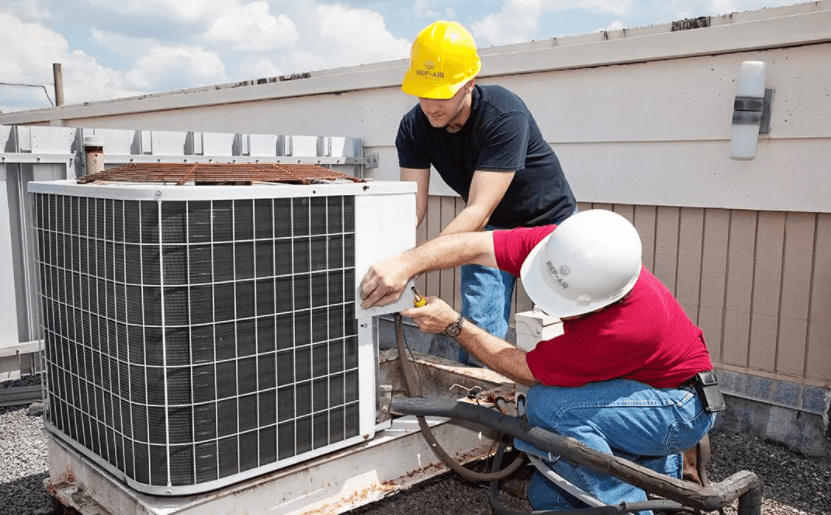
HVAC Installation: Learn The Process In 6 Steps

Installing a Heating, Ventilation and Air Conditioning (HVAC) system in your home may seem complicated, but with a little guidance we think you can pull it off. Even if you have no HVAC experience, this step-by-step guide may provide the breath of fresh air that you're craving. Keep in mind that your local government may require hiring a certified licensed HVAC technician. In this likely event, it's still important to understand what is going on so that you can oversee the project.
When to Install an HVAC System
Early spring is the best time to replace an old HVAC system—simply because it won't be needed for the year's highest or lowest temperatures while offline. Replacing an HVAC system can really be done any time of the year in moderate climates but, obviously, the sooner the better.
A new HVAC system can be one of the best investments made to a home and the happiness factor is high: Think convenience and comfort. Also, heating and air conditioning typically account for as much as 50% of an energy bill, so modernizing a low-efficiency system is going to pay off.
Early in the pandemic, we all learned how vital maintaining HVAC is to our health. The "air space" or common environment for everyone living in your home, is how germs spread and pollutants increase misery for those with asthma and allergies. Outdated HVAC systems don't filter contaminants, so modernization can drastically improve the air quality within your home.
Advancements in HVAC systems in the past decade offer energy-efficiency, and new technology learns from your habits and adjusts accordingly.
Safety Considerations
If you have any doubts, remember you can always consult a licensed professional. And if you smell smoke or gas, contact the fire department. The best way to ensure a safe working environment is to stop and think: Do you smell gas? Are you aware of any electrical malfunctions in your home? Is anything in your home structurally unsafe?
Each of these could potentially cause serious hazards while working on the HVAC system. Any problems should be shored up before beginning work on the HVAC system. Also, you can help protect yourself on the job with the following:
-
Safety glasses
-
Wear gloves when handling sharp tools or materials like ducting
-
Lift with your legs, not with your back
Don't drink alcohol on the job;
Tools
- Reciprocating saw
- Vacuum pump
- Refrigerant scale
- Cordless drill
- Screwdrivers
- Pipe wrenches and pliers
- Snips and shears
- Multimeter and voltage tester
- Safety glasses
- Gloves
- Measuring tape
- Flashlight(s)

Instructions
Correctly Size New System; Calculate Heating and Cooling Loads
It's important to make sure to find the right-sized unit—the size of a new HVAC can make a home comfortable or feel suffocating.
Installing an incorrectly-sized unit leads to premature wear and tear, shorter lifespan of the system, increase in energy bills and inconsistent temperatures throughout the home during different seasons. A qualified technician should conduct load calculations by gathering the correct information before making a recommendation, so if you’re doing measurements yourself, be as thorough as possible.
This first part of an installation is to calculate the home's Heating Load Worth (HLW), which considers the home’s location, age, size and construction materials, as well as nearby trees and sun exposure.
Investigate and Upgrade Current Ductwork
HVAC systems are expensive, so it's important to make sure they're working properly. First check the ductwork for any damage or debris that could be blocking airflow. Clear all obstructions, most of which you'll find at outflow and info registers—often called sends and returns.
Look for leaks and repair and seal any problem areas before moving on to other maintenance, like cleaning. Even if you purchase the best unit possible, an HVAC system won't obtain optimal performance without tightly sealed ducts and adequate insulation around them. Both factors improve efficiency by cutting down energy costs while ensuring proper operation.
One option for upgrading a system may simply be repairing an existing system. You may prefer a ductless heating and cooling system that entails simply cutting holes in the walls to connect indoor registers with outdoor heating and cooling units.
Find the Ideal Location for Your Unit
Choose the location for your unit, whether you've chosen an indoor or outdoor system. It would be ideal if you did a thorough site evaluation then mark out (using spray paint or chalk) where you want the unit to go. Be thorough with your measurements when deciding on the placement (measure twice, cut once).
Installing the Unit
Most modern units are wall-mounted, but in the event that you've chosen to install a brand-new duct system, we recommend you follow the instructions that come with the unit itself. Variation among existing manufacturers, and those who may be offering products in the future, necessitate this simple expedience.
Whether you've chosen a wall-mounted system or a more complicated full-house system, remember the steps above before picking up any tools. Manufacturer guidance should always be followed—both for ensuring proper function and maintaining the warranty.
Verify that the HVAC System is Running Smoothly
An incorrectly installed HVAC system can reduce performance by as much as 30%. You should first do a final check before flipping the switch on any brand-new HVAC, including listening for any unusual noises and ensuring that airflow and temperature are consistent in every room. Complete basic maintenance tasks to learn how best to take care of your new equipment.
HVAC Safety Hazards Every Homeowner Should Know
Turn off the power to the circuit servicing your HVAC at the electrical circuit-breaker panel—that gray box in some closet that used to have fuses but now just means flipping switches. You can test if any current still flows through that line with an electrician-approved multimeter before touching anything related to the circuit.
One of the main HVAC accidents is exposure to dangerous chemicals such as some refrigerants. To work with these substances, formal safety training must be completed. Some substances can cause serious burns or other injuries. Having an understanding of each chemical will help you make appropriate choices when handling it.
Some refrigerants are labeled "safe" by manufacturers, but may pose a hazard if exposed to heat in any form, whether solar radiation, electric heating coil or even human body temperature.
Be prepared for any potential accident. Don't take any shortcuts to avoid additional costs.
When to Call A Pro
If you're in over your head, hand your tape measure and gloves to someone who belongs to the nationwide organization of professional HVAC technicians. Hiring a technician to complete your job doesn't mean you're off the hook. Use this guide to check his or her work, establish a timeline and make sure things are done properly.
Source (Partial): Forbes

Leave a comment